
The History of CANDLES Online Exhibit
Sharing highlights of CANDLES from the last 25 years
From One Person to an Organization
CANDLES Holocaust Museum and Education Center opened its doors on April 30th, 1995. In the beginning, there was one woman on a mission to tell her story of survival and educate the children of Indiana about the Holocaust. In the 24 and half years that followed, Eva successfully completed her mission; but along the way, CANDLES as a museum grew into its own identity. The in-house exhibits expanded from home-made posters to professionally created and installed exhibitions that are story-driven. CANDLES worked to establish professional partnerships that allow the museum to expand the reach of its mission beyond the local community and the state of Indiana. One such partnership enabled CANDLES to install an interactive exhibit that is a meaningful and unique experience for our guests. The guests number about 12,000 per year and are delighted with the museum’s lessons about the Holocaust, Eva’s unique story, and the ability to hear survivors’ testimonies. The 25-year history of CANDLES exhibit below highlights the milestones that the museum has reached and the challenges that Eva and the museum have overcome. All photos and documents are stored in the CANDLES archive.
-
February 21, 1984: Founding of the Organization C.A.N.D.L.E.S.
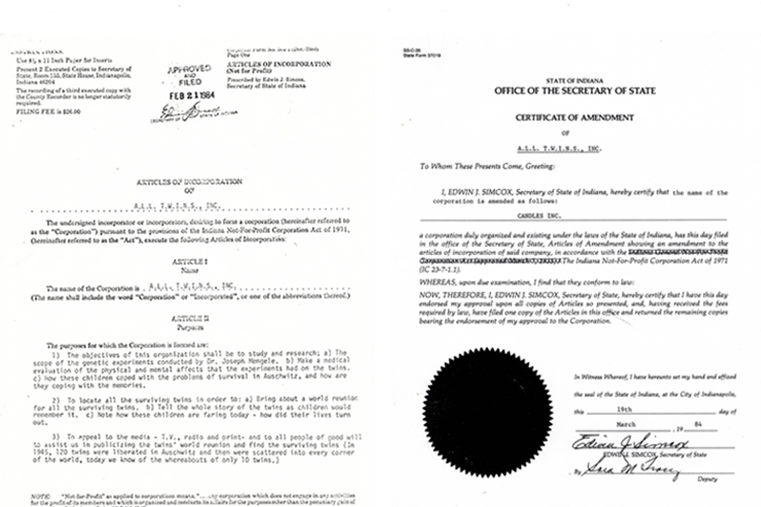
Frustrated by the difficulties she experienced in her search for answers about the Mengele Twins experiments she and Miriam experience in Auschwitz, Eva, along with some of her fellow twins and a small group of local friends, founded C.A.N.D.L.E.S., an acronym for Children of Auschwitz Nazi Deadly Lab Experiments Survivors, (later simplified to CANDLES). C.A.N.D.L.E.S. gave a new brand of legitimacy to Eva’s work. Through the organization, Eva was able to find even more Mengele Twins and push the world to dig deeper into the mysteries surrounding Dr. Mengele.
Photo 1 Caption (A.L.L. T.W.I.N.S. Founding Document): The 1984 founding articles of incorporation for A.L.L. T.W.I.N.S., Inc. (Auschwitz Lab’s Living Twins World Institute & Network of Survivors). Later that year, A.L.L. T.W.I.N.S. would change its name and become C.A.N.D.L.E.S.
Photo 2 Caption (Name Change): In March of 1984, A.L.L. T.W.I.N.S., Inc. became C.A.N.D.L.E.S., Inc.
-
September 2, 1984: Mengele Twins Featured in "Parade Magazine"
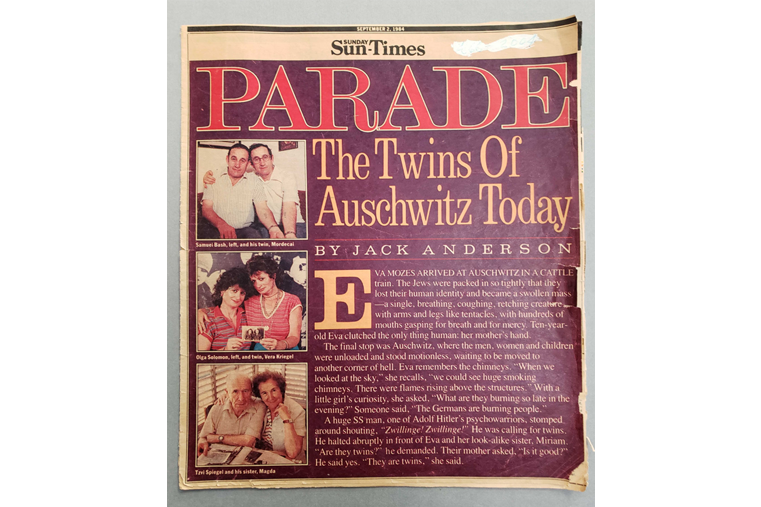
The decision to create an organization dedicated to finding the Mengele Twins turned out to be a good one. The world began to listen to Eva and her fellow twins. In September of 1984, Jack Anderson, a writer for Parade Magazine, wrote a story featuring several Mengele Twins, including Eva. The story was a major step toward bringing more awareness to CANDLES’ mission.
Photo Caption: An original copy of the September 2, 1984, feature “The Twins of Auschwitz Today” in Parade Magazine. The story referenced multiple Mengele Twins and highlighted Eva’s story.
-
June 6, 1993: Eva’s Sister, Miriam, Passes Away
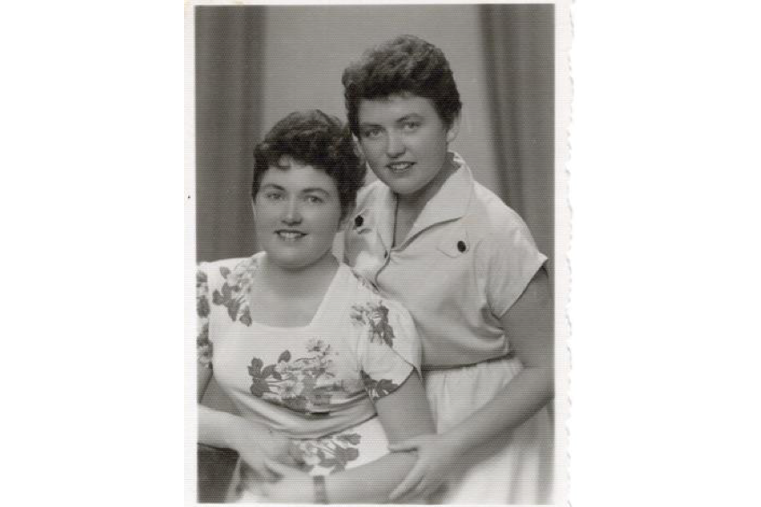
On June 6, 1993, Miriam Mozes Zeiger died after years of battling the lingering effects of the Mengele Twin experiments, eventually succumbing to cancer. Feeling like she had lost part of herself, Eva was devastated. In search of a way to honor Miriam, Eva founded the CANDLES Holocaust Museum and Education Center in her memory in 1995.
Photo Caption: Eva (left) and Miriam (right) during their time living in Israel after the war. When Eva married fellow Holocaust survivor, Mickey Kor, and moved to the United States, Miriam stayed in Israel where she had started a family.
-
January 27, 1995: Dr. Hans Münch and Documenting the Gas Chambers
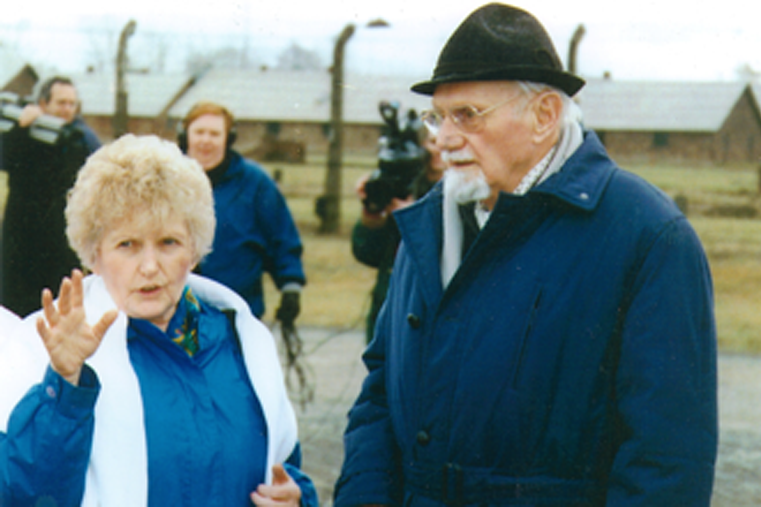
In pursuit of information about their files from the experiments, Eva flew to Germany to interview Dr. Hans Münch, a former SS physician who was stationed at Auschwitz. Although he did not know anything about their files, Dr. Münch did know how the gas chambers operated. Part of Dr. Münch’s job in Auschwitz was to watch the gassings, wait until everyone was dead, and then sign mass death certificates for the victims of the gas chambers. Dr. Münch was tried in Warsaw after the war and was the only defendant acquitted of war crimes because of his role in protecting the lives of some inmates and his refusal to participate in selections. At Eva’s request, he agreed to sign an affidavit confirming the existence and use of gas chambers in the Auschwitz camp system. As a way to thank Dr. Münch, Eva decided to write him a letter of forgiveness. This was the beginning of Eva’s journey toward forgiving the Nazis and freeing herself from her past. You can read the affidavit about the gas chambers here.
Photo Caption: Eva Mozes Kor and Dr. Hans Münch in Auschwitz-Birkenau during the commemoration of the 50th anniversary of the liberation of Auschwitz. Eva and Dr. Münch signed documents on Birkenau’s selection platform. Eva signed her personal declaration of amnesty while Dr. Münch signed an affidavit confirming the existence of the gas chambers at Auschwitz.
-
January 27, 1995: Eva’s Declaration of Amnesty

During the commemoration of the 50th anniversary of the liberation of Auschwitz, Eva brought Dr. Münch to the selection platform in Auschwitz-Birkenau. While there, she read and signed her declaration of amnesty, forgiving the Nazis for the wrongs committed against her. Eva forgave in her name only, and forgiveness became one of the cornerstones of her life lessons that she shared during presentations in the museum and around the world.
Photo Caption: The original copy of Eva Kor’s declaration of amnesty signed by Eva and six witnesses on the selection platform in Auschwitz-Birkenau. Eva specifically worded the document to emphasize that she forgave the Nazis in her name only.
-
April 30, 1995: CANDLES Holocaust Museum and Education Center Opened in Honor of Miriam
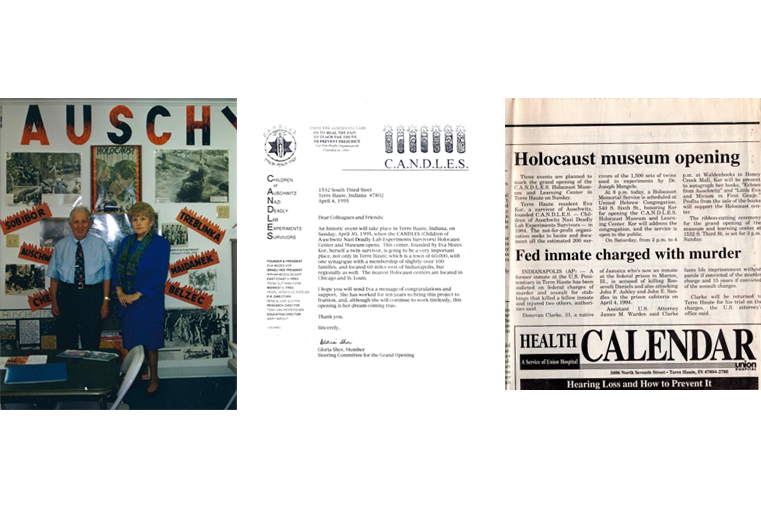
On April 30, 1995, Eva opened the CANDLES Holocaust Museum and Education Center in a small strip mall on the south side of Terre Haute; it occupied roughly one-third of the building. The museum was dedicated to the memory of Eva’s twin, Miriam. It focused on teaching about the Holocaust and highlighting the stories of the Mengele Twins. The museum was, and is still, the only Holocaust museum in Indiana.
Photo 1 Caption (Mickey and Eva): Eva Mozes Kor and her husband, Mickey Kor, stand in the original CANDLES Holocaust Museum and Education Center. Eva led the development of the exhibit and used the museum as a platform to share her story and the stories of the Mengele Twins.
Photo 2 Caption (Letter): A letter from steering committee member Gloria Sher announcing the opening of the CANDLES Holocaust Museum and Education Center. Because of Miriam’s work with the original C.A.N.D.L.E.S. organization, Miriam is listed as “Israeli Vice President.”
Photo 3 Caption (Newspaper): A story from the Terre Haute Tribune Star published on April 28, 1995, announcing the grand opening of the CANDLES Holocaust Museum and Education Center. The story includes information on three events held around Terre Haute to commemorate the opening of the museum.
-
1999: Eva, Bayer AG, and Nazi Medical Experiments at Auschwitz
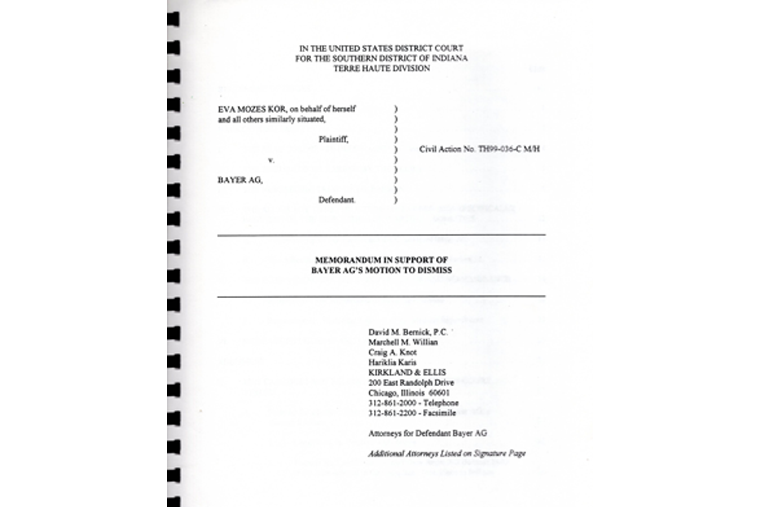
In 1999, Eva learned that a well-known pharmaceutical company, Bayer Corporation, had historic ties to Nazi medical experimentation. Armed with everything she had learned about the experiments, Eva filed a class action human rights lawsuit against Bayer. The stories of the Mengele Twins proved to be key to the lawsuit’s success, and the courts ruled in favor of Eva and the other victims. Eva’s lawsuit and the other cases it inspired resulted in a settlement of over $5 billion spread over all victims of experiments during the Holocaust and to pay the lawyers.
Photo Caption: The cover page of the court case filed by Eva against Bayer in 1999.
-
June 7, 2001: Max Planck Symposium in Berlin
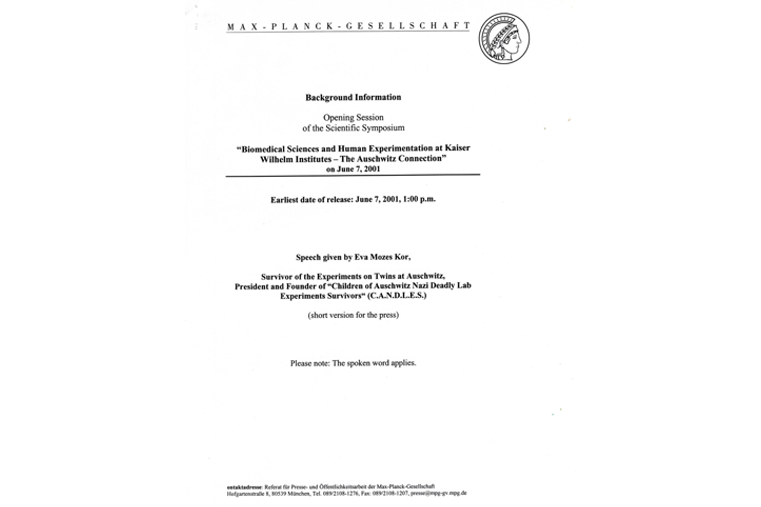
On June 7, 2001, Eva presented at the Max Planck Society, the former Kaiser Wilhelm Institute in Berlin, Germany. During World War II, the Kaiser Wilhelm Institute was a hub for Nazi eugenics and Nazi medical experimentation. One SS doctor, who had strong ties to the Institute, was Dr. Josef Mengele. With the backing of her work through CANDLES, Eva lectured on medical ethics and her experiences during the Holocaust.
Photo Caption: An information sheet on Eva’s lecture entitled “Biomedical Sciences and Human Experimentation at Kaiser Wilhelm Institute - The Auschwitz Connection.”
-
November 18, 2003: CANDLES is Firebombed
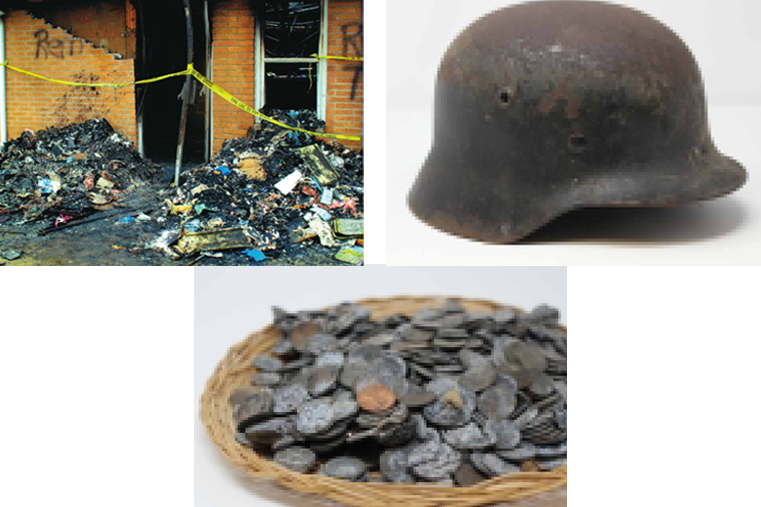
On November 18, 2003, an arsonist set fire to CANDLES. The arsonist also sprayed painted the words, “Remember Timmy McVeigh,” on the side of the museum building. McVeigh, a domestic terrorist who was executed in Terre Haute, Indiana, after bombing the Alfred P. Murrah Federal Building in Oklahoma City, Oklahoma, was suspected to have had ties to the white nationalist movements in the United States. The fire was treated as a hate crime, though no one was ever charged. The museum and its contents were destroyed save for a small number of damaged artifacts and the shell of the building.
Photo 1 Caption (Building): An image of the entrance to the CANDLES Holocaust Museum and Education Center after the arson. The museum was a total loss and only a handful of artifacts survived.
Photo 2 Caption (Helmet): A Nazi-era German military helmet that was housed in the original CANDLES Holocaust Museum and Education Center building. The helmet was one of the few artifacts that survived the fire.
Photo 3 Caption (Pennies): These pennies were collected by local students with the goal of collecting six million, one for each Jewish life lost in the Holocaust. Eva and the firefighters who responded to the fire knelt on the ground in the rain by the remains of the museum to collect what few pennies could be saved. The pennies are currently on display in CANDLES Holocaust Museum and Education Center’s “Choices” exhibit.
-
April 3, 2005: Museum Reopens After the Fire
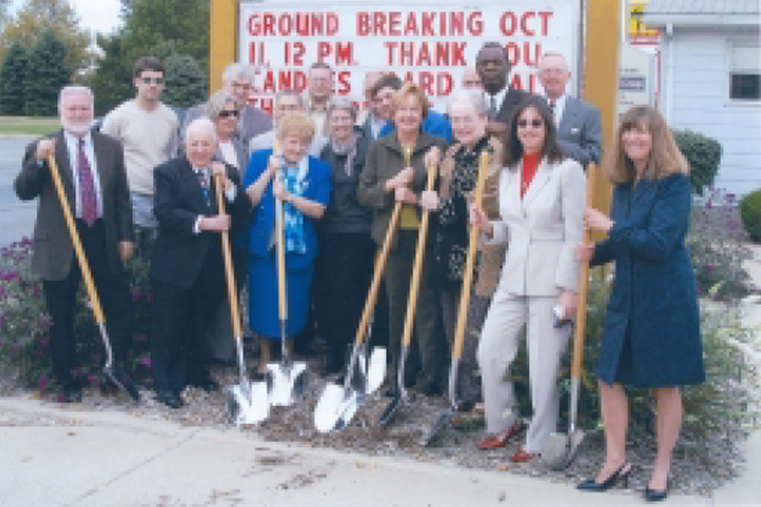
After the museum was lost to arson, the Terre Haute community and donors from around the world rallied behind Eva and CANDLES. In response to the hate that destroyed the original museum, students, volunteers, supporters, and survivors raised over $300,000 to rebuild the museum. Eva, along with her husband Mickey and members of the community, broke ground on the new CANDLES Holocaust Museum and Education Center on October 11, 2004. The new museum opened on April 3, 2005, one and a half years after the fire. The new museum now spans the entire 3,700 square-foot structure.
Photo Caption: Eva, Mickey, board members, construction workers, and members of the Terre Haute community break ground on the new CANDLES Holocaust Museum and Education Center on October 11, 2004.
-
December 4, 2014: “Choices” Exhibit Grand Opening
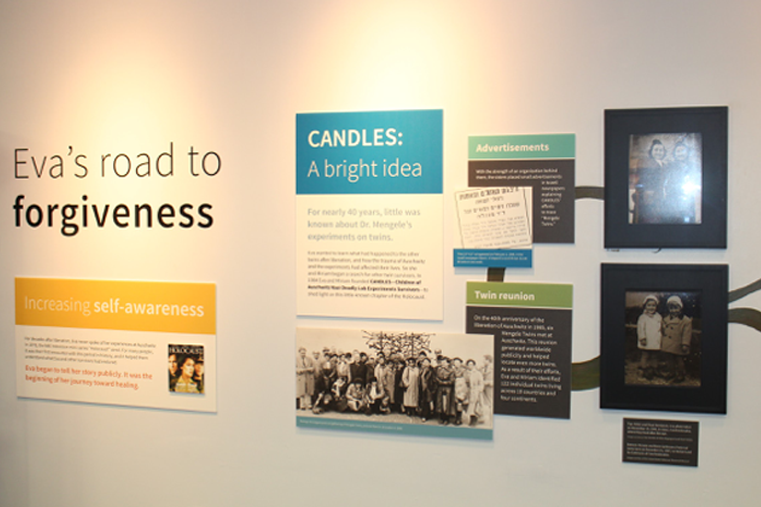
In 2014, CANDLES began work on a new exhibit to highlight some of the most important lessons of the Holocaust and Eva’s story. Led by CANDLES’ former program director, Dorothy Chambers, the museum embarked on a full renovation of its main exhibition space. The final result was the “Choices: The Holocaust Through Eva’s Story” exhibit. One of the chief lessons it teaches is that the Holocaust was not an inevitability; it was the result of choices made by people at all levels. The exhibit has been a major draw for school groups and other guests to reflect on how individual choices influenced the development of the Holocaust.
Photo Caption: The “Eva’s Road to Forgiveness” section of the “Choices” exhibit discusses how Eva came to forgive the Nazis and start her path to healing from the trauma of the Holocaust. It discusses how CANDLES came to be and the work Eva did to preserve the stories of her fellow Mengele Twins. This section of the exhibit can be seen by touring CANDLES Holocaust Museum and Education Center.
-
April 5, 2018: The "Eva: A-7063" Documentary Premieres

Eva worked incessantly to increase her impact and the impact of CANDLES around the world. When she and CANDLES were approached by Ted Green Films, Mika Brown, and WFYI to create a new documentary about her life, Eva recognized the potential to spread the CANDLES mission and her story far beyond the museum’s walls. The multi-year partnership of CANDLES, Ted Green Films, and WFYI resulted in the film Eva: A-7063 that premiered on April 5, 2018. It has since been screened in several US states, multiple countries, and has been carried by almost every PBS affiliate in the United States.
Photo Caption: A program from the world premiere of Eva: A-7063. The film became a national and international success and led to the creation of in-school programs to teach about Eva’s story.
-
March 9, 2019: "Dimensions in Testimony" Grand Opening
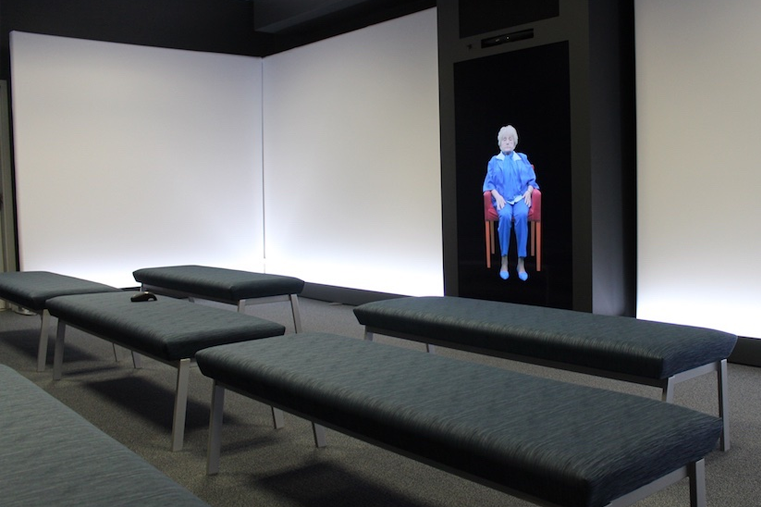
Recognizing the need to preserve Eva’s legacy and her unique ability to engage with visitors, CANDLES partnered with USC Shoah Foundation on the Dimensions in Testimony project. As a founding partner, CANDLES hosted a test version of two of the digital images in order to troubleshoot and create an extraordinary experience for visitors. The partnership culminated in a permanent installation at the CANDLES Holocaust Museum and Education Center where guests can engage with Eva and eleven other Holocaust survivors in a question and answer setting. The exhibition’s grand opening was held on March 9, 2019.
Photo Caption: USC Shoah Foundation and David Korins Design created the Dimensions in Testimony theater at CANDLES. The exhibit allows guests to interact with twelve Holocaust survivors, including Eva Kor, by asking questions about the survivors’ stories before, during, and after the war.
-
July 4, 2019: Eva Kor Passes
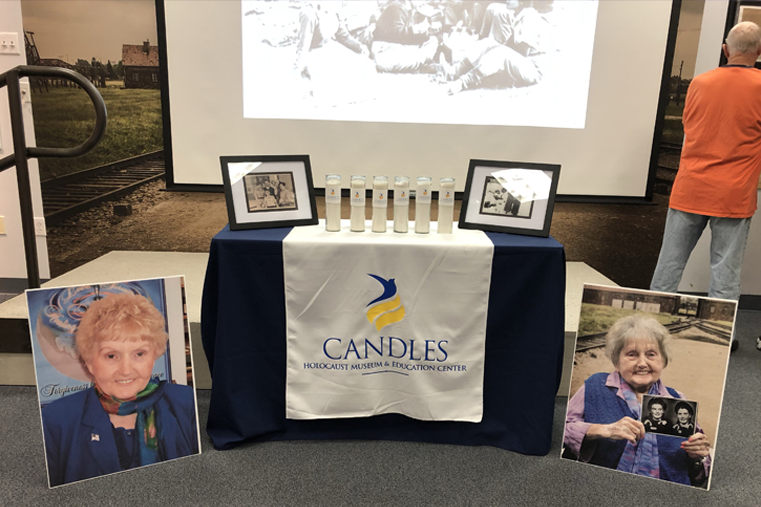
On July 4, 2019, CANDLES founder Eva Mozes Kor passed away while on the annual CANDLES trip to Auschwitz. Her passing represented the end of an extraordinary life defined by a fierce determination to survive the Holocaust, remember the life of her sisters, and heal the world. While Eva’s presence at the museum is irreplaceable, CANDLES continues to tell about Eva and to teach her four life lessons:
- Never, ever give up
- Prevent prejudice
- Forgive your worst enemy
- Appreciate your parents: “Give your parents an extra hug and an extra kiss for all of us kids who don’t have parents to hug and kiss.”
Photo Caption: CANDLES honored Eva with a public display at the museum featuring photos of Eva and her work throughout the years. Members of the community participated in a candle lighting ceremony in remembrance and left their own personal notes and memories about Eva.
Thank you for learning more about the history of CANDLES.
If you have any questions or would like to learn more about CANDLES, please email info@candlesholocaustmuseum.org.
